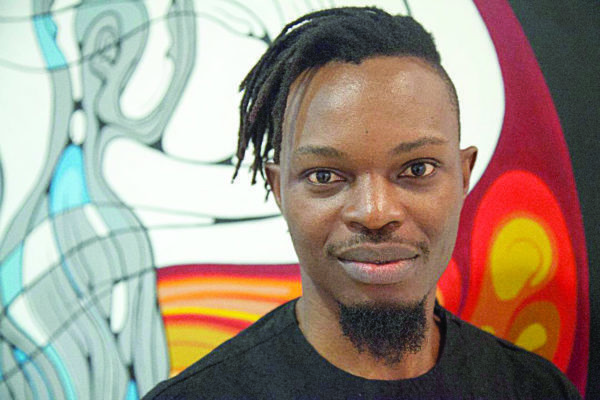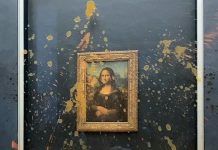Rivers State-born Promise Onali studied fine art at the University of Nigeria, Nsukka, where he graduated with a degree in painting in 2007. His love for comic books and science and his pre-occupation with figuring out the inner workings of things, influenced his experimental painting style. His use of diverse media to explore scientific questions is grounded in strong linearity and embryonic metaphors. Onali’s fascination with how our nerve endings disperse energy and electric charges which give birth to ideas and thoughts are reflected in the subtle layers of his mixed media works.
In this interview conducted at a preview of an exhibition titled: Diffusion, curated by SMO Contemporary Art, the young and talented artist talks about his techniques, messages and practising art in Nigeria.
So, my technique is an ambiguous interplay of colours, fabrics, wire gauze, wood and a host of other unconventional materials which tell the stories of the human experience, using Africa’s consciousness evolution as a point of departure.
Why the reoccurring circles and embryos?
My paintings of circles and embryos are metaphors for the evolution of consciousness, with most of the figures in profile, embedded in circles or laden with embryonic swirls which represent the consciousness bubble of each individual, family, community, nation, etc. We find ourselves in these bubbles of our own creation and it influences the way we interact with other people and handle sensitive situations. Embryos represent our state of consciousness and it grows every day, but it’s growth rate depends heavily on what and how we feed it.
Did you always think that you’ll become an artist?
Yes but there were hitches that almost marred that dream. After I graduated from the University of Nigeria Nsuka in 2007, I decided to do art in 2010 but I started working fully in 2011.
So what were the hitches?
That came from my mum and family friends. It wasn’t easy initially. I mean my mum didn’t want me to study art because she didn’t see any future in art and I had a lot of family friends too who put pressure on me to study something from the sciences. So, I was actually reading to study architecture and then I was having difficulty because I’m good with writing but not with calculations. So, I failed the first JAMB because I couldn’t make the cut-off. That happened because I wasn’t able to do the calculations in physics and chemistry.
I began studying for the second JAMB and then my brother who was already in school told me that since I was writing JAMB that why did I want to suffer myself going for architecture which I knew I couldn’t do.
Being in a school that had an art department, my brother was amazed with what fine art students were doing, so he suggested that since I’m very good in art and even better than some of them, that I should go and study art. So that was it. I went into UNN and the rest is history.
How has it been practising art in Nigeria?
Practising in Nigeria has not been an easy task. A situation whereby you’re not taken seriously simply because you are an artist. They write you off just looking at your hairstyle or your looks. Sometimes when people look at your works, they would say oh! it’s nice but how do you make money?
I’m like, these are my works and I have to sell them to make money and they would be like, you mean people buy these things? People have actually asked that question over and over.
And do people buy your works?
Of course yes. They do buy but not as frequently as we would want them to.
I’ve read about what other artists do in America and Europe, the kind of prices they command for their works. We are really really far behind. Okay let me say this; last year, I sent my work for an auction in France, the price I put was like five times the price I sell here. But they wrote back to me saying that they were not going to accept the work except I changed it because the price was too low for their margin. So you can understand that we still have a long way to go. Look at some of the auctions here in the country where people sell a work for 5 or 7 million, it is still not there. That’s absolutely low. In America, people sell small canvases for $20,000.
Any other challenges?
There are also the challenges of getting a space to work as well as showing my works. I started doing large canvases but again and again where do I show those works? I want to do experimental works but where do I show them? The spaces are not enough. The only space dedicated to such works is CCA and even at that, CCA is still a small space. Other larger spaces want to show something they believe they can easily sell, the Nigeria factor I guess.
How long does it take you to produce a piece of art work?
It depends on the size of the work. Sometimes it takes me weeks or days. For Satori vs Entropy for instance, which is also on display at Temple Muse, it took months to make the collection because I was actually exploring and I had to move because my studio space wasn’t so big. So I moved everything out because they were large canvases. Also, in between, I was working on other smaller pieces; that’s why it took that long to complete.







